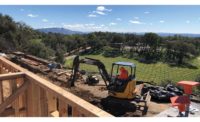U.S. Firm Helps China Rebuild After Deadly Quake
Dujiangyan, a city of 630,000 people in central China, ranks among the most visited tourist destinations in the country. Historians cite its Qingcheng Mountains as the birthplace of Taoism, and at the base of these densely forested peaks is the famous Dujiangyan Irrigation System, a 2,250-year-old network of distributaries that still provides water to farmers. Furthermore, the local panda reserve is home to 43 of the nation’s beloved giants.

More recently, however, Dujiangyan has drawn worldwide attention for the tragic scene that unfolded there on May 12: It was the city nearest the epicenter of the 7.9-magnitude earthquake that rocked Sichuan province, killing more than 80,000 people and leaving at least 4.8 million homeless.
While the ancient dam largely escaped harm, the cityscape did not fare so well. The downtown was mostly wiped out, and in addition to 3,000 deaths, more than 50 percent of residences were destroyed. The devastation was so massive that the rubble will not be cleared entirely from the downtown core until the close of 2009, says architect Chengzhi “Harry” Lu.
That’s not to say the rebuilding effort has not begun. Lu is managing principal of the Shanghai office of WWCOT Architects, a 59-year-old California firm. On June 10, the firm was selected by the planning department of Chengdu, Sichuan’s capital city, to participate in rebuilding of Dujiangyan. The department chose 10 different entities, from a Beijing-based social science institute to WWCOT, to create plans for different aspects of urban life, such as public transportation and sanitation infrastructure; WWCOT is envisioning basic urban-design principles. The firm had only one month to submit its ideas. According to Lu, authorities want to complete all residential construction within seven months, and all rebuilding by mid-2010.
WWCOT’s contribution involves several changes to the city plan. Most momentous, the city center will be shifted 20 miles to the east, closer to Chengdu. Beyond accommodating a forecasted 30 percent population growth, this allows the government to start reconstruction while it continues to clean up the quake wreckage. “If someone’s home was damaged, usually he would have to live in a tent, and then move among three or four different temporary apartments,” Lu explains. “The government would rather have victims move from tents to permanent residential areas.” The strategy also places Dujiangyan residents closer to the Chengdu airport.
In the new core, significant green space between buildings will provide a public amenity. And once cleared, the former downtown will be maintained as a public park, amplifying efforts—such as construction of 10 art museums—to further entice visitors to the city. Lu says that due to the size and visibility of the rebuilding effort, not to mention the government’s strapped resources, many of these design principles will be adopted by cities throughout the province.


